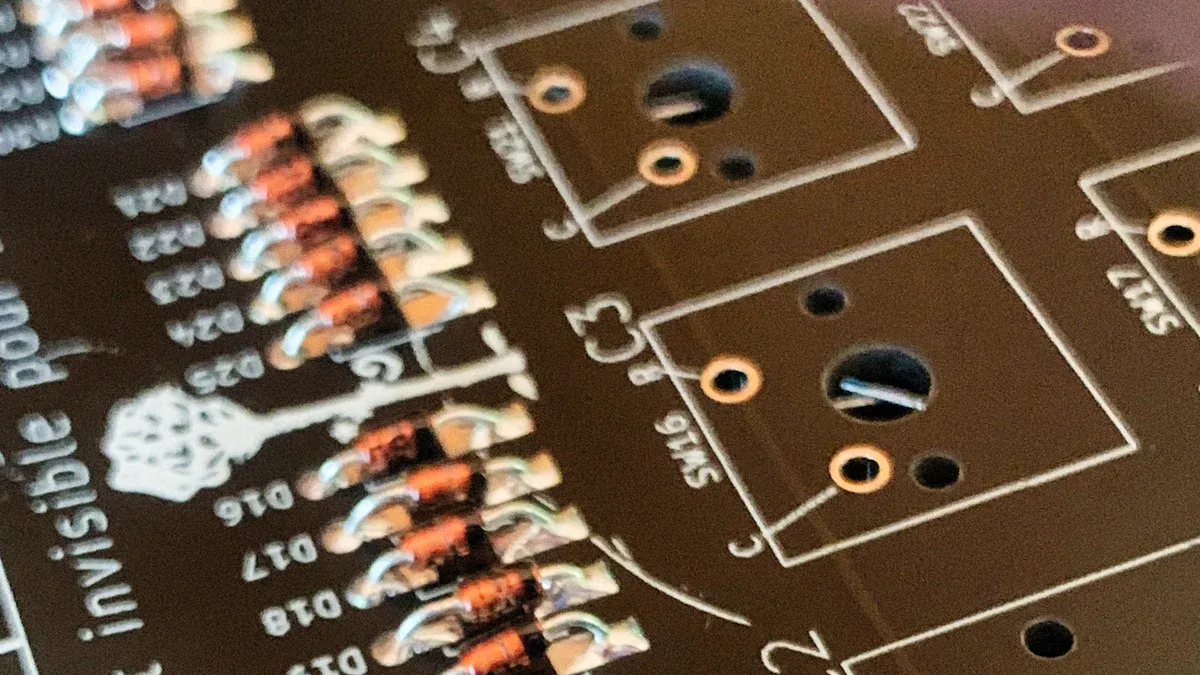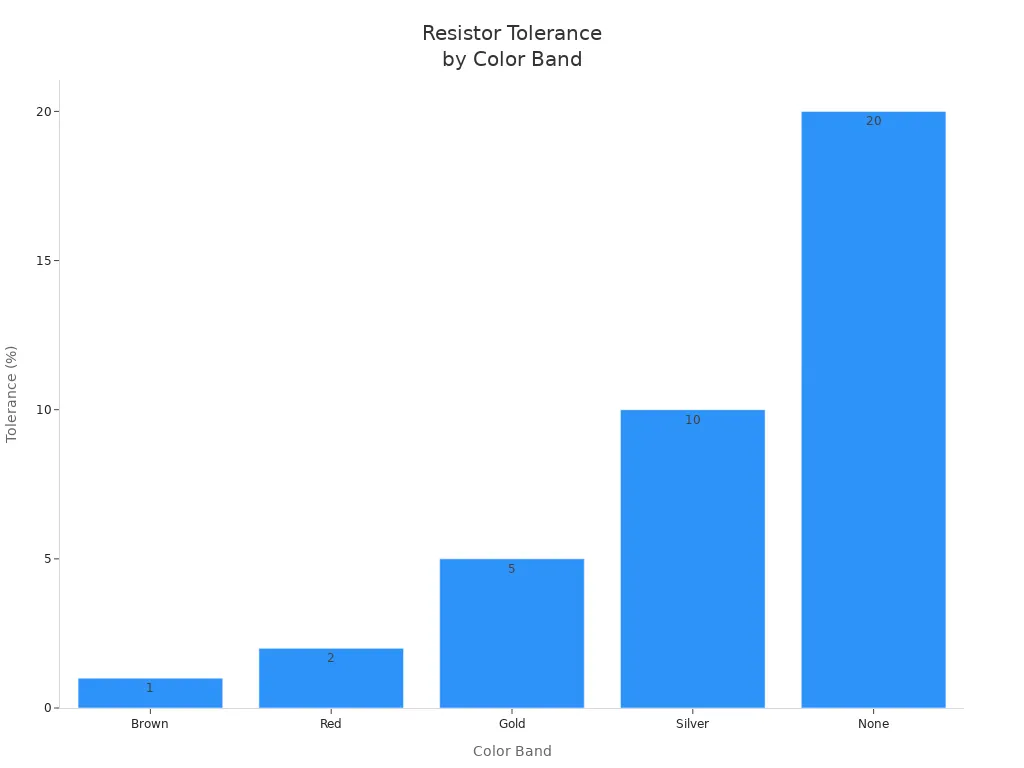You use the resistor color code to find out resistance, tolerance, and sometimes reliability. Colored bands go around small resistors, so you can see them from any side. This system is clear, even if the resistor is on a busy circuit board. Manufacturers pick color bands because they are easy to put on and cheaper than printing small text.
Color coding also stops mistakes, since you do not have to mix up letters or numbers. This method works well for small electronics, Modular Connectors, and tiny parts like CR2450 batteries.
Key Takeaways
The resistor color code uses colored bands to show resistance, tolerance, and sometimes reliability in a fast and clear way. You read the bands from left to right. The first bands are for digits. The next band is for the multiplier. The last band is for tolerance.
Four-band resistors are common and simple to read. Five-band resistors give more exact values for circuits that need accuracy. Using the color code helps you avoid errors, save time, and work with resistors from any brand with confidence. Memory tricks, charts, and tools like calculators or multimeters help you read resistor values faster and more easily.
What Is the Resistor Color Code?
Definition
The resistor color code uses colored bands to show details about a resistor. These bands tell you the resistance, tolerance, and sometimes reliability. The IEC 60062 standard says axial resistors have three to six colored bands. Two bands show the main numbers for resistance. Another band is the multiplier. Some resistors have more bands for tolerance or reliability. The standard explains how to read the bands and what to do with special cases like zero-ohm resistors. It also matches the color code with common resistor values. This system gives you a clear way to read resistor values from any country.
Purpose
Resistors are small, so printing numbers is hard. The colored bands help you find resistance and tolerance fast. You do not need special tools. The bands help you tell resistors apart, even if they look the same. The color code also shows how much the resistor can change from its value or how reliable it is. The system works for both regular and precision resistors. You read the bands from left to right. Each color stands for a number, a multiplier, or a tolerance.
The resistor color code helps you check values quickly and makes fewer mistakes, especially with many parts.
The IEC 60062 standard sets the rules for this system. It covers color bands for leaded resistors and codes for surface mount types. The standard makes sure everyone uses the same method. This helps you design, fix, and build circuits with confidence. The resistor color code also helps with mass production and keeps things simple for everyone.
-
You can see resistance, tolerance, and sometimes reliability right away.
-
The system is good for small resistors where printing is hard.
-
The color code helps you avoid mistakes and saves time when fixing things.
-
You get a method that works for parts from any brand.
Color Bands
Band Meanings
You see colored bands on most resistors. Each band has a special job. The first two or three bands show the main numbers of the resistor’s value. The next band tells you the multiplier, which means how many zeros you add. The last band shows the tolerance. Tolerance tells you how much the real value can change from the number you read. Some resistors have an extra band for reliability, but you usually see this only in special parts.
Tip: Always read the bands from left to right. The band closest to one end is usually the first digit.
Here is a quick guide to what each band means:
-
First Band: First digit of resistance
-
Second Band: Second digit of resistance
-
Third Band (if present): Third digit (for 5-band resistors)
-
Multiplier Band: How many times to multiply the digits
-
Tolerance Band: How much the value can change
Color Values
Each color stands for a number. You use these numbers to figure out the resistor’s value. The table below shows what each color means for digits, multipliers, and tolerance:
|
Color |
Significant Digit Value |
Multiplier Value |
Tolerance Value |
|---|---|---|---|
|
Black |
0 |
×1 Ω |
N/A |
|
Brown |
1 |
×10 Ω |
±1% |
|
Red |
2 |
×100 Ω |
±2% |
|
Orange |
3 |
×1 kΩ (×1,000) |
±3% |
|
Yellow |
4 |
×10 kΩ (×10,000) |
±4% |
|
Green |
5 |
×100 kΩ (×100,000) |
±0.5% |
|
Blue |
6 |
×1 MΩ (×1,000,000) |
±0.25% |
|
Violet |
7 |
×10 MΩ (×10,000,000) |
±0.10% |
|
Gray |
8 |
×100 MΩ (×100,000,000) |
±0.05% |
|
White |
9 |
×1 GΩ (×1,000,000,000) |
N/A |
|
Gold |
N/A |
×0.1 Ω |
±5% |
|
Silver |
N/A |
×0.01 Ω |
±10% |
You can also use this chart to help you remember the color values:

If you practice reading these bands, you will get faster at finding resistor values. This skill helps you work with circuits and avoid mistakes.
Reading the Resistor Color Code

Understanding how to read the resistor color code helps you find the value of any resistor quickly. You can use this skill to check parts before you build or repair a circuit. Most resistors use either four or five color bands. Each type has its own reading method.
4-Band Resistors
You will see four color bands on most standard resistors. Here is a step-by-step guide to reading them:
-
Hold the resistor so the tolerance band (usually gold or silver) is on the right.
-
Start from the left and note the colors of the first two bands. These bands give you the main digits of the resistance.
-
Look at the third band. This band is the multiplier. It tells you how many zeros to add or what number to multiply by.
-
The fourth band shows the tolerance. This tells you how much the actual resistance can change from the value you read.
Tip: Always use a color code chart to match each color to its number. This chart helps you avoid mistakes and makes reading faster.
Here is a simple formula you can use:
Resistance (Ω) = (First digit × 10 + Second digit) × Multiplier Example
Suppose you have a resistor with these bands: brown, black, red, and gold.
-
Brown = 1 (first digit)
-
Black = 0 (second digit)
-
Red = 100 (multiplier)
-
Gold = ±5% (tolerance)
So, the resistance is (1 × 10 + 0) × 100 = 1,000 Ω (1 kΩ) with a ±5% tolerance.
5-Band Resistors
Some resistors use five bands. These resistors give you more precise values. Here is how you read them:
-
Hold the resistor with the tolerance band (often gold, silver, or brown) on the right.
-
Read the first three bands from the left. These bands give you the three main digits of the resistance.
-
The fourth band is the multiplier.
-
The fifth band is the tolerance.
This method works well for precision resistors. You can use the same color code chart, but you add one more digit before the multiplier.
Example
If you see these bands: red, violet, black, brown, and brown:
-
Red = 2 (first digit)
-
Violet = 7 (second digit)
-
Black = 0 (third digit)
-
Brown = 10 (multiplier)
-
Brown = ±1% (tolerance)
The resistance is (2 × 100 + 7 × 10 + 0) × 10 = 270 × 10 = 2,700 Ω (2.7 kΩ) with a ±1% tolerance.
Note: Five-band resistors are common in circuits that need high accuracy.
Practical Examples
You will find the resistor color code on almost every through-hole resistor in real circuits. You can use a color code chart to decode the bands and find the exact value. For example, a resistor with green, blue, red, and gold bands means:
-
Green = 5
-
Blue = 6
-
Red = 100 (multiplier)
-
Gold = ±5% (tolerance)
So, the value is (5 × 10 + 6) × 100 = 5,600 Ω (5.6 kΩ) with a ±5% tolerance.

You can use a multimeter to double-check the value, especially if the colors are hard to see. In real-world circuits, you may also match resistors by measuring several and picking ones with close values. This is important for precision work.
Common Mistakes and How to Avoid Them
|
Common Mistake |
How to Avoid |
|---|---|
|
Misreading color bands in poor light |
Use bright lighting and a magnifying glass |
|
Confusing the multiplier band |
Double-check with a color code chart |
|
Skipping the tolerance band |
Always include the tolerance band in your reading |
|
Reading bands in the wrong order |
Start from the end closest to the edge or opposite the tolerance band |
|
Not verifying with a tool |
Use a multimeter for confirmation |
Practice reading resistors often. Keep a color code chart nearby. Use digital tools or apps if you need extra help.
The tolerance band is important. It shows how much the real resistance can change from the value you read. For example, a gold band means the resistor can vary by ±5%. This helps you pick the right resistor for your circuit.
The resistor color code gives you a fast and reliable way to find resistor values. You can use this system to save time and avoid errors in your projects.
Importance
Standardization
Standardization helps you every time you use resistors. The color bands follow the same rules everywhere. This lets you read resistor values quickly and easily. You get many benefits from this system:
-
You find resistor values and tolerances fast. This saves time when you build or fix things.
-
You can use resistors from any brand. The color codes always mean the same thing.
-
You make fewer mistakes reading resistor values. Your circuits work better.
-
You use a system that people know all over the world. This helps with design, making things, and learning.
-
You get more safety and convenience in today’s devices.
Standard color codes stop confusion. They help your projects go well.
Error Reduction
The color code system helps you make fewer mistakes. The bands show you the value, multiplier, and tolerance in a clear way. You see the numbers first, then the multiplier, then the tolerance. This order helps you check your work and catch errors before you start.
If you do not use the standard, you can have big problems. Some people spend weeks fixing circuits because of wrong or hard-to-read color bands. Bad color contrast or thin bands can make you read the wrong value. If you mix up colors or skip the tolerance band, your circuit might not work right.
You must read resistors correctly for many jobs. This is important for testing, fixing, and buying parts. You need the right value for things like limiting current, dividing voltage, protecting LEDs, and reducing noise. The color code system helps you avoid mistakes and keeps your circuits safe.
Memory Tips
Mnemonics
You can use mnemonics to remember the order of resistor colors. These memory tricks help you recall the color sequence quickly. Many beginners find them helpful when starting out. Here are some popular phrases:
-
"Bad Booze Rots Our Young Guts But Vodka Goes Well"
Each word’s first letter matches a color: Black, Brown, Red, Orange, Yellow, Green, Blue, Violet, Gray, White. -
"Betty Brown Rapes Other Young Girls Because Victor Grey Wouldn’t"
This phrase also follows the color order.
You can also link the colors to the rainbow. Think of ROY G. BIV (Red, Orange, Yellow, Green, Blue, Indigo, Violet) and add Black, Brown, Gray, and White. This method helps you visualize the sequence.
Tip: Practice sorting real resistors by color. Handling many resistors in a short time helps you remember the order better than just repeating mnemonics.
Quick Reference
Quick reference tools make reading resistors much easier. You do not need to memorize every color or do math in your head. These tools include color code charts, calculators, and apps. They help you avoid mistakes and speed up your work.
-
Use a color code chart to look up values fast. Charts show the color, digit, multiplier, and tolerance in one place.
-
Try a resistor calculator. Enter the colors, and the tool gives you the resistance and tolerance right away.
-
Keep a chart or calculator near your workspace. This helps you check values quickly, especially if you see faded or confusing bands.
-
Use a multimeter to double-check your reading. This step is important when you want to be sure of the value.
-
Reference tools help you read both 4-band and 5-band resistors. They also show standard values and tolerances.
Note: Many engineers and students keep a printed chart or use a phone app for quick access. These tools help you work faster and with more confidence.
When you learn to read resistor color bands, you get a useful skill. This skill helps you choose the right parts and make fewer mistakes. It also lets you fix circuits more quickly. Practice a lot and use memory tricks or charts to feel more sure of yourself.
-
You get faster and better at working with electronics.
-
You can help others by giving clear information.
If you want to learn more, check out guides from TE Connectivity or use online resistor calculators. These tools help you get better at electronics.
FAQ
What if I cannot see the color bands clearly?
You can use a magnifying glass or a bright light to help you see the bands. If the colors still look faded, try measuring the resistor with a multimeter for an accurate reading.
Can two resistors have the same color bands but different values?
No, each unique color band combination gives only one value. If you see two resistors with the same bands, they have the same resistance and tolerance.
Why do some resistors have more than four bands?
Resistors with five or six bands give you more precise values or extra information, like reliability. You often find these in circuits that need high accuracy.
Do I need to memorize the color code?
You do not need to memorize it. You can use a color code chart, a calculator, or a phone app. Many engineers keep a chart nearby for quick reference.






